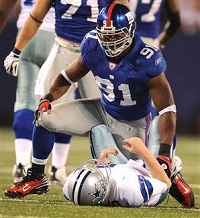[adsenseyu1]
A few weeks ago Jason LaCanfora published a list of best and worst contracts in the NFL so I thought it might make a good idea for us to do the same here at OTC, with a team by team approach. I’ll try to be a bit more analytical in terms of why money was paid and how it fits in the market, but the general premise is the same. The one key difference is outside of restructured rookie contracts under the old CBA we will only use veteran contracts as there is a big difference between best draft picks and best contracts. Please note that there is a difference between a bad player and a bad contract when discussing some of the selections. Clicking on a players name will take you to his salary cap page.
 Best Contract: Justin Tuck
Best Contract: Justin Tuck
I had a very difficult time coming up with this decision. The Giants rework contracts so often that sometimes the deals get so bad at the backend that a good deal kind of goes bad. I considered Chris Snee, who has been a relative bargain at Guard for many years, but yearly restructures have left the Giants with a bad 2013 and 2014 cap scenario with Snee. Cullen Jenkins is a pretty good deal for a one year flier on a player that can provide an interior pass rush and I could see putting him in this position, but Tucks’ is a bigger contract and stands out from all the others with regards to contract treatment.
While Tuck struggled to make an impact last season and is looked at negatively right now with his $6.15 million dollar cap charge, that is simply a Giants decision to allow him to play things out at that figure. The Giants had structured his deal so that he would only carry a $1.5 million dollar cap hit if released this year. They never jumped back in on him to raise that charge when restructuring every other player around him, even as he came off a Pro Bowl in 2010. Normally the low dead money is the kind of leverage that would lead to a paycut if the team chose to use their leverage that way.
From an annual value perspective Tuck’s $6.2 million per year number is a tremendous bargain at the position. As a key backup in the Giants 2007 season in which he produced 10 sacks, the Giants pounced on the opportunity to re-sign Tuck, who they knew would likely be a starter in 2008, during their Super Bowl run. Tuck had one year remaining on his rookie contract, slated to pay him just $520,000, which the Giants used to help negotiate favorable terms. Usually a 10 sack season leads to big contracts or at least big deals with numerous incentives, neither of which was the case with Tuck, whose contract contained modest escalators on the backend for Pro Bowls and sacks, of which just $1 million were earned.
Over the life of the contract Tuck made two Pro Bowls and had two 10+ sack seasons. The decision to extend a year early allowed the Giants to smooth out the cap hits to their advantage. Tuck never had a cap charge over $7.65 million and most years his cap charge was around $5 million. Most importantly they never made the deal worse, which they did with many other deals. Philosophically this may be part of the Giants internal visions, locking up pass rushers young and continuing to draft them so they can move on as the age and health becomes more of a concern. Regardless of the reasoning the Giants got a great deal with Tuck and if they choose to part ways this summer they will create $4.5 million in cap room with no further damage in 2014.
 Worst Contract: Corey Webster
Worst Contract: Corey Webster
While Webster did take a paycut this year to remain a Giant, even the paycut just added to the poor extension they signed Webster to back in 2008. Webster, who had never been selected to a Pro Bowl, was signed to a 5 year extension worth $8.7 million a year, at the time one of the most expensive deals at the position. His $29.5 million three year payout was close to the top of the NFL corner market and Webster was never anywhere near that level of player. Since then Webster has been an ok starter until seemingly coming apart at the seams last season.
The Giants made the backend of Webster’s deal more difficult to work with by converting $3.6 million of salary in 2009 and $3 million in salary in 2011 to prorated bonuses to help their salary cap situation. As a result of the contract structure, which already paid Webster a $5.25 million dollar signing bonus, his cap charges in 2012 and 2013 were over $9 million a year and his dead money in the final year of a 5 year deal totaled $2.59 million.
The Giants would go on to make a curious decision to keep Webster in the fold in 2013 by reducing his $7 million dollar cash salary to $4.25 million, with $2.5 million fully guaranteed. Webster will still carry a cap charge over $5 million on the season, a number the Giants kept artificially low by getting into the void year contract structure that has compromised teams such as their rivals the Dallas Cowboys. The Giants have started to dip their toe into this contract structure with some lower tier talent due to salary cap problems and need to be careful to not extend the concept much further. As a result Webster, who ranked 111th in coverage by Pro Football Focus in 2012, will leave the Giants with $1.25 million in dead money next season when his contract voids.
Check out Our Other Best & Worst Contract Articles
AFC East: Buffalo Bills, Miami Dolphins, New England Patriots, New York Jets
AFC North: Baltimore Ravens, Cincinnati Bengals, Cleveland Browns, Pittsburgh Steelers
AFC South: Houston Texans, Indianapolis Colts, Jacksonville Jaguars, Tennessee Titans
AFC West: Denver Broncos, Kansas City Chiefs, Oakland Raiders, San Diego Chargers
NFC East: Dallas Cowboys, New York Giants, Philadelphia Eagles (July 14)
[subscribe2]